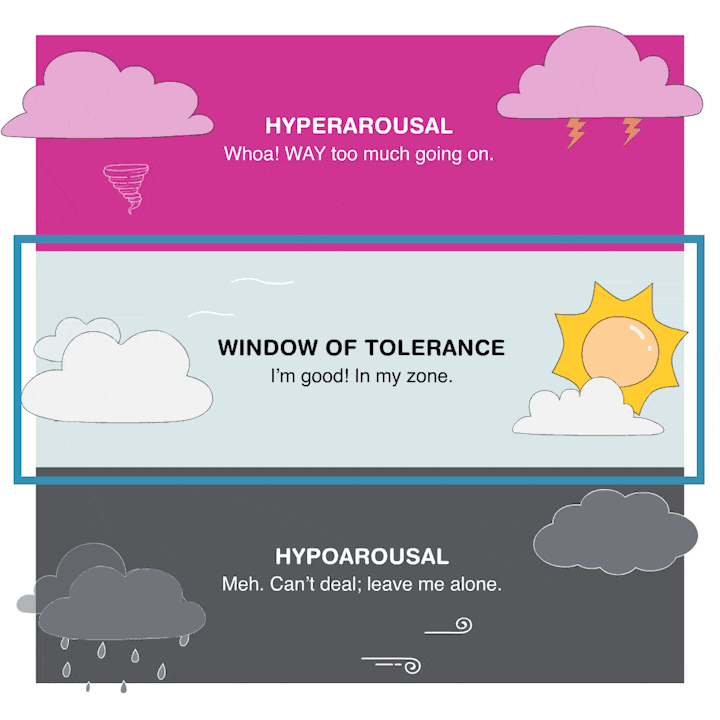Since the start of the pandemic, having a routine and feeling connected to others has been more difficult than ever, especially for young people. From adapting to changing health guidelines to adjusting to different ways of learning, it’s OK if your mental health is feeling challenged in new and different ways. Here, Kids Help Phone shares information and tips for understanding how your body responds to and copes with stress through a concept called the Window of Tolerance.
What is the Window of Tolerance?
The Window of Tolerance is a term created by a psychiatrist named Dr. Dan Siegel to help you understand how your body reacts to stressful times and events. It’s a way to reflect on what happens when our bodies and minds are stressed or feel threatened. Often, we may feel responses or reactions in our bodies before we notice what we’re feelings or thinking.
Without you even noticing it, your body’s nervous system (the part of you that connects your brain to the rest of your body) is always managing your energy levels, heart rate, breathing and lots of other things to help keep you alive. If you’re stressed or in danger, it’ll automatically make changes to the energy in your body to protect you and keep you safe. For example, triggering your “fight, flight or freeze” response. It’s the same for animals. Think of a dog barking at a burglar (fight), a caribou running away from a wolf (flight) or a deer caught in a car’s headlights (freeze).
How does it feel to be within, above or below your Window of Tolerance?
Being within your Window of Tolerance zone tends to be where you feel most comfortable, in control and able to cope. You may think more clearly, have an easier time making decisions and take better care of yourself. It’s important to note that being within your window doesn’t mean that things are perfect. For example, you might be stressed and have lots of energy or be tired and have little energy, but can still have enough energy to think and feel at the same time.
Having lots or too much energy means you’re in the hyperarousal zone, or above your Window of Tolerance. If you’re above your window, you may feel restless, aggressive, impulsive or anxious. Your thoughts may race, and you may feel overwhelmed. You may experience physical sensations such as sweating, heavy breathing, heart beating faster, etc.
Having not enough or too little energy means you’re in the hypoarousal zone, or below your Window of Tolerance. If you’re below your window, you may feel disconnected, fatigued, paralyzed or depressed. It may be hard to think or be able to say no to things. You may not experience as many physical sensations as usual, or have a sense of numbness, shoulders feeling heavy, etc.
Each person’s window — meaning, their ability to cope with difficult situations at any given time — can change, increase or decrease based on factors outside their control. For example, the COVID-19 pandemic is a factor that may cause people to have smaller Windows of Tolerance because of the stressors, grief and/or change that it’s causing. You can also have a smaller window if you’ve had a traumatic or difficult experience in the past.
Reflecting on your Window of Tolerance
It’s helpful to check in with yourself regularly to reflect on things going on in your life and create time and space to notice how different situations and challenges are impacting you. It’s important to note that your goal isn’t to get rid of being above or below the window (it’s common to move outside your window sometimes), but to use your self-awareness to get back inside your window when you notice you’re outside of it.
With more self-awareness and practice, you can make your Window of Tolerance bigger so that you can be inside it more often. Having a bigger Window of Tolerance may also help you to recognize when other people are outside their windows, and increase your ability to help them get back into their window.
You can use these questions to draw your own Window of Tolerance based on how you’re feeling today:
- What physical sensations tell you that you’re above / within / below your Window of Tolerance?
- What can help you to get back to your window if you’re above it (high energy or hyperaroused)?
- What can help you get back in your window if you’re below it (low energy or hypoaroused)?
- Remember a time when you were “in” your window. How did that feel?
Activities to help expand your Window of Tolerance
If you’re below your window, you can try doing things that wake up your senses, like eating something sour or mint–flavoured, or washing your face with cold water. If you’re above your window, you can try activities that shift your energy, like dancing, jumping jacks or screaming into a pillow.
Wherever you currently are in your Window of Tolerance, there are things you can do to help expand your window so you can cope and feel strong, calm and grounded. Grounding techniques, breathing exercises and practicing mindfulness are some activities that can be helpful. It’s important to explore and find the activities that work best for you. Remember that different activities and tools will help at different times. You can be proud of yourself for taking the time to increase your self-awareness and look after your well-being.













